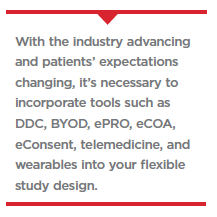 Clinical trial managers have used digital technology for several years to some degree. Now, because of the pandemic, digital technology has become a proven and valuable necessity. However, for all the benefits of bring your own device (BYOD), electronic patient-reported outcomes (ePRO), and direct data capture (DDC), historically, design and implementation challenges have hindered widespread adoption.
Clinical trial managers have used digital technology for several years to some degree. Now, because of the pandemic, digital technology has become a proven and valuable necessity. However, for all the benefits of bring your own device (BYOD), electronic patient-reported outcomes (ePRO), and direct data capture (DDC), historically, design and implementation challenges have hindered widespread adoption.
Given decentralized trials — whether fully virtual or hybrid — reduce costs, deliver cleaner data, and improve patient acceptance and engagement, it’s time to break through design and implementation roadblocks.
Flexible Study Design Is Key
Design needs for decentralized trials (DCTs) vary. Many studies benefit from a combination of in-person site visits and remote intermediate and follow-up assessments. This structure enables the use of digital technology at the appropriate frequency in the trial timeline.
For rapid study implementation, consider an agile, interactive design-build cycle for eCOA, ePRO, and DDC questionnaire screens. For patient centricity, design questionnaires to look like familiar, paper-based forms. This approach involves intensive collaboration between developers and the sponsor to configure prototypes and updates, but pays off in patient engagement, retention, and adherence improvements.
Typical bottlenecks for assessments include license holders, translations, and hardware availability. Engaging license holders early to get buy-in and agreement can prevent delays. A good working relationship with a top translation vendor can expedite screen translations and migrations. It’s also important to plan ahead for wearables and mobile devices, including provisioned options. When video visits are part of the protocol, sponsors may need to provide some patients with tablets.
A few additional best practices:
Allow sites to use existing telemedicine platforms when needed
Let patients use what they know: embrace a BYOD approach when possible
Use solutions that enable direct capture of data regardless of patient location
Use a platform with an integrated, easily accessible help desk
It’s Time for Real-Time Data
eSource DDC solutions for DCTs provide earlier insights into patient well-being and protocol adherence, responding when values fall outside of a set target range. For example, certain patient diary responses could trigger an alert regarding potential safety concerns, allowing the study team to follow up right away.
 Data managers and monitors also benefit from remote technology. With little to no travel, monitors can oversee data from numerous sites and issue manual queries — all while using the same tools deployed by the virtual coordinator to collect the data.
Data managers and monitors also benefit from remote technology. With little to no travel, monitors can oversee data from numerous sites and issue manual queries — all while using the same tools deployed by the virtual coordinator to collect the data.
With data captured directly, monitors can focus on source data review (SDR) and observing trends and outliers, which is a more proactive approach to data monitoring. Source data verification (SDV) is unnecessary because DDC eliminates the transcription step where the errors that SDV is designed to catch originally occur.
These and other efficiencies lead to easy review of source documents and audit trails with reduction in data queries, faster resolution, cleaner data, and accelerated database lock. Other DDC methods, such as physician notes, drawings, audiovisual recordings, ECGs, and lab results, can also be entered into the electronic research record. Process simplifications like these give study teams more time for patient care — especially important for overworked clinicians.
DCTs Give Patients, Sites, and Sponsors Flexibility and Options
With the right technology, DCTs can reach more patients, keep them engaged, and ease data collection while improving data monitoring, data quality, and integrity.
With the industry advancing and patients’ expectations changing, it’s necessary to incorporate tools such as DDC, BYOD, ePRO, electronic clinical outcome assessments (eCOA), eConsent, telemedicine, and wearables into your flexible study design. A vendor experienced in DCTs will help you clear design and implementation hurdles with ease.(PV)
Clinical Ink, a global clinical technology company, offers data certainty from source to submission via our Lunexis eSource clinical technology and configurable direct data capture, eCOA, ePRO+, and eConsent modules. This suite of solutions for capturing and integrating electronic data from sites, clinicians, patients, and caregivers at its source naturally enhances clinical trial workflows. For virtual, traditional, or hybrid trials, Lunexis technology reduces manual labor and associated delays, and provides anytime, anywhere data access, saving resources as your trials progress.
For more information, visit clinicalink.com.

















